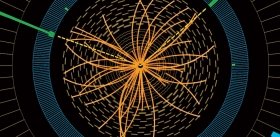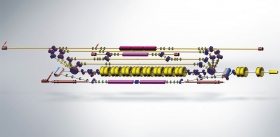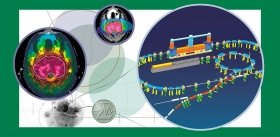Excursion in the "State" of the Institute of Nuclear Physics: Where Particles Are Born
The issue of the matter-divisibility limits dates back to the 5th century B. C. In antiquity, in addition to a discrete pattern of the world known as atomism, the belief in infinite divisibility of matter was also fairly popular. Even Democritus, the founder of atomism, believed that atoms — indivisible, eternal, and invariable particles — consist of smaller elements, which have practically no size at all. Antique disputes about these unclear objects, however, were purely speculative
The result of experimental investigations of the structure of matter at the end of the 19th century was the discovery of the atomic nucleus and elementary particles. A new vision of particles was proposed by Paul Dirac, who developed a theory aimed at describing electron motion in late 1920s. The theory revealed the fundamental symmetry of matter and antimatter and predicted the existence of an “antielectron” having the mass of an electron but oppositely charged. Indeed, such a particle — positron — was discovered two years layer.
When it became clear that the entire matter observed consists of atoms, and the latter consist, in turn, of neutrons, protons, and electrons, physicists almost believed that they finally managed to find the ultimate “bricks” of the universe — infinitely small and indivisible units of matter.
A principally new stage of research into subatomic phenomena, however, started in early 1930s. Improvement of experimental techniques and development of new instruments for the detection of elementary particles allowed discovering new kinds of the latter. Thus, 6 elementary particles have been known by 1935, 18 by 1955, and more than 100 by now. In this situation, the use of the term “elementary” as applied to these particles is merely a tribute to tradition.
As a result, the problem of matter divisibility is solved today in an absolutely unforeseen manner. It turned out that two high-energy particles during their collision break into fragments whose sizes, unexpectedly, are not smaller than those of the primary particles. New particles emerge owing to the kinetic energy involved in the collision process. The only method of further division of particles is their collision with the use of high energy. Thus, we can divide the matter again and again without obtaining smaller fragments: new particles merely arise from the energy used.
Thus, elementary particles are divisible and indivisible at the same time. This seems to be paradoxical as long as we keep to the idea of “building bricks.” Yet, this contradiction is reconciled if particles are considered as certain dynamic “essentials” or, more correctly, as processes utilizing a certain amount of energy contained in their mass. During a collision of two particles, their energy is redistributed and forms a new set of “essentials.” If the kinetic energy of the collision is sufficiently high, the new set can include additional particles that were not present in the initial set.
The main method used currently to study the properties of elementary particles is based on their high-energy collisions; that is why this part of physics is also called the high-energy physics. A high level of the kinetic energy of particles is obtained in huge setups reaching several miles in circumference — accelerators — where particles are accelerated to velocities close to the velocity of light.
If particles are considered to be elementary, how can their collision result in fragmentation? It is not merely identical particles but a particle (electron) and its antiparticle (positron) that collide in electron-positron accelerators. Annihilation can give birth to new structures, and it is the latter that produce fragments to be examined. The higher the energy of colliding particles, the heavier particles emerge in the experimentYury A. ROGOVSKY, post-graduate student, chief laboratory assistant:
Relativistic machine
Facilities with colliding beams are now the main sources of information in the elementary-particle and high-energy physics. The energy of particles interacting in such colliders continuously increases: from 250 MeV in the first electron storage ring VEP-1 (INP SB RAS) to 2x7 TeV in the proton-proton Large Hadron Collider currently under construction at the European Сenter of Nuclear Research (CERN).
INP has extensive experience in creating electron-positron storage rings with high luminosity. The VEPP-2M booster ring with an energy of particle generation ranging from 0.36 to 1.4 GeV was in successful service here in 1972—2000. The process of radiation self-polarization of beams was observed on VEPP-2M for the first time in the world, and the method of precision measurement of the electron energy, now successfully used elsewhere to measure the masses of elementary particles, was put into practice. During the years of its existence, the facility has been modernized several times, and there were several generations of detectors of elementary particles.
COLLIDER — accelerator with opposing (colliding) beams of charged particles
ELECTRON-VOLT (eV) — unit of energy popular in high-energy physics.
1 eV – energy acquired by an electron passing through a potential of 1 V; it approximately corresponds to 10,000 °С;
MeV (mega-electron-volt) — million of eV;
GeV (giga-electron-volt) — billion of eV;
TeV (tera-electron-volt) — million of millions of eV
LUMINOSITY — important parameter of the accelerator characterizing the number of particle collisions at the point of the collision of beams in a cross section per unit time. The greater the number of collisions, the higher the chance that something interesting will emerge
COOLING of the beam — decrease in the velocities of elementary particles in the beam reference system. In other words, it is not sufficient to speed up particles, it is necessary that they pass in a compact group and do not scatter
In 1999, the INP administration decided to significantly upgrade VEPP-2M to increase luminosity and maximum reachable energy up to 2 GeV. The new project was entitled VEPP-2000, where 2000 indicates the number of MeV to be obtained rather than the millennium as many people think. A natural question arises: Why do we need an accelerator with such a comparatively small energy, whereas machines with a power almost thousand-fold greater are already available? The answer is simple: when you need to drive a nail, you do not take a hand sledge — it is more convenient to use a small hammer.
All modern accelerators are sophisticated multi-component systems, which can be considered by using an example of the VEPP-2000 machine.
First, it includes an electron gun, which is a source of electrons. Then there follows a synchrobetatron, where the electron energy increases from 30 to 250 MeV. In the storage cooler BEP, the particles obtained previously are accumulated, and their energy further increases to 900 MeV. Finally, there follows the main booster ring of VEPP-2000 with a perimeter of 24 m, where charged particles move along closed circular trajectories, as in all cyclic accelerators.
A charged particle in the magnetic field is known to move along a circular trajectory; therefore, the main closed orbit in the accelerator is generated by dipole magnets with a vertical magnetic field. The accelerator size is normally limited by the available space, and this is the reason why rather strong magnets have to be used. Thus, to reach a design beam energy of 1 GeV, the magnetic field strength should be 24 kGs, which exceeds the natural magnetic field of the Earth by a factor of more than 30 thousand!
In straight-line segments, the beam is controlled by magnets with a special configuration of the magnetic field — the so-called quadrupole lenses. The name of these magnets was due to their influence on the beam. Like a conventional optical lens diffracts the light beam, these magnets can focus or defocus the beam of particles flying though them.
A specific feature of VEPP-2000 is the use of novel optical devices for reaching a high design luminosity of 1032 cm-2 x sec-1.The optical scheme of the accelerator implements the concept of circular beams proposed at INP in 1989. The method is based on the disposal of betatron coupling resonances in transverse motion, which affect the dynamics of circulating beams, owing to the generation of an additional integral of motion — the longitudinal component of the angular momentum. This scheme will be implemented in practice by using superconducting solenoids for focusing the beams at their “meeting point.” VEPP-2000 will be the first facility in the world with this type of optical instrumentation
An essential element of the accelerator is a resonator. This is a device where the beam is accelerated by an electric field, because it is known that a charged particle moves with acceleration in a longitudinal electric field. The resonator resembles a closed cylinder with an electric field reaching the maximum strength at the point where the beam passes and at the time it passes. Passing through the resonator in each round, the beam is accelerated by energy imparted in small portions; after a large number of rounds, it is accelerated to a velocity fairly close to the velocity of light.
Collisions of the electron and positron beams that can give birth to a new particle occur at two diametrically opposite points surrounded by advanced detectors of elementary particles.
Main tool
The VEPP-4M electron-positron collider is an upgraded facility on which high-energy physics research was performed at INP as long ago as 1980-1985. At present, this is the main collider of the institute, on which both high-energy physics and photonuclear studies and synchrotron radiation experiments are performed.
After 1985, a new elementary-particle detector KEDR was installed in the experimental gap of the accelerator. The accelerator was originally intended to study the physics of Y-mesons (upsilon-mesons) — complex systems consisting of a heavy b-quark and its antiquark — and two-photon processes, in which photons, rather than electrons, collide in the accelerator.
In recent years, however, it has been decided to concentrate on the energy range of 3.0—3.6 GeV. The reasons for this are, first, the increased interest of the scientific community in the investigation of the physics of ψ-mesons (psi-mesons) and τ-leptons and, second, and not least, strong competition in the research area of higher energies.
Δm/m is the ratio of the mass measurement accuracy to the mass, i. e., the relative accuracy. In experimental physics, the answer is not a number but a number plus/minus a measurement error. In most cases, the labor expenditure in estimating the accuracy of the measured quantity far exceeds the difficulty of obtaining the the number itself. It is like in sport, but there the efforts are concentrated on increasing the speed/range, and here they are concentrated on increasing the accuracy.Neutrons, protons, and electrons are particles that constitute matter on the Earth. Muons (µ) and pions (π) can easily be detected in space beams. In contrast, J/ψ- and ψґ-mesons in sufficient amounts for studies are produced only in experiments. The most accurate measurements of the masses of J/ψ- and ψґ-mesons have been performed at the Novosibirsk Institute of Nuclear Physics of the Siberian Branch of the Russian Academy of Sciences. Accurate measurements of the masses of these particles allow one to develop a reliable energy scale in this range of energies in order to further increase the measurement accuracy of parameters of elementary particles. The theory in this area of physics is far from being completed. Elementary particles are the simplest subjects of study in physics, but until now many things could not have been predicted; for example, it is still not clear why the particles have exactly these masses. A particular theory can be validated only by experiments
A distinctive feature of the accelerating complex is the precision energy measurement using the resonant depolarization method, which is described below. This is the only technique that accurately measures the masses and parameters of resonances — unstable particles with amass exceeding the proton mass — which are generated only in experiments at our energies.
Ivan B. Nikolaev, junior researcher:
Breakthrough accuracy
Experiments on high-accuracy determination of the masses of elementary particles require ultrahigh-accuracy techniques for measuring the energy of electron and positron beams colliding in the accelerator. One of such techniques — the resonant depolarization method — was developed at our institute as long ago as 1975. It was employed to measure the masses of elementary particles from the class of mesons, and measurements are currently in progress to determine the mass of the τ-lepton.
Briefly, the essence of the resonant depolarization method is as follows. In the accelerator, charged particles (in our case, electrons) move in a circular orbit at a velocity only forty billionth lower than the velocity of light, which is known to be about 300 000 km/hrs. When moving, they radiate photons — light quanta. This radiation is called synchrotron radiation. In addition, in the accelerator electrons form peculiar bunches, each of which contains about ten billion particles.
In our measurements, we use two electron bunches, one of which is polarized, and compare the electron scattering intensities in the bunches. An abrupt jump in the relative difference of the amount of scattered electrons in the polarized bunch compared to that in the unpolarized bunch corresponds to the time of depolarization of the bunch. The numbers under the points are values of the electron energy in the beam that correspond to the depolarizer frequency. The energy measurement accuracy is 1—2 keV —only one-millionth of the beam energyEach electron is a small spinning top. Its rotation cannot be accelerated or slowed down and, therefore, it even has a special name — spin. In the accelerator, the spin direction precesses (rotates) around the direction of the accelerator magnetic field, and the velocity of this rotation depends on the electron energy. Therefore, by measuring the velocity of spin precession, it is possible to determine the energy of elementary particles.
The spins of all beam electrons point in different directions, and the rotation of an individual electron cannot be seen. In this case, synchrotron radiation comes to the rescue. It causes the electron spins to gradually align in about the same direction — opposite to the magnetic-field direction: polarization of the bunch is said to occur. At INP, electrons are first polarized for about an hour in the VEPP-3 accelerator, and the polarized electrons are then accelerated in VEPP-4M.
When the spins of all ten billion electrons begin to point in one direction, the spin polarization and precession velocity can already be measured. The bunch is subjected to a varying electric or magnetic field produced by a special device — depolarizer. When the frequency of this field reaches a certain value, depolarization of the bunch occurs — the spins of all electrons point variously again.
Plot of energy fluctuations in the accelerator. The difference between the measured and predicted energies is plotted on the ordinate, and time in days on the abscissa. Pronounced daily dynamics is clearly seen. The appreciable growth in the fluctuation amplitude is related to the spring season: one part of the accelerator thawed first and then the other. Siberia is not Switzerland!Electron polarization can be traced by studying electron-electron scattering in the bunch because some of the electrons are knocked out from it and, having made one or two rotations around the accelerator ring, are incident on the walls. Recording such electrons by counters and finding an insignificant (only 1—2 %) change in their amount, it is possible to determine the time of disturbance of the polarization and, hence, the spin precession frequency. After that, determining the energy of elementary particles in the beam is a matter of skill.
E. M. Baldin:
Simply KEDR
As to why the detector was called so, the history of INP is silent. KEDR is simply a name, like a person’s name.
KEDR is a classical detector of elementary particles. It deserves inclusion in manuals: to some extent, it incorporates all units or systems used in modern detectors.
The detector is like a nested doll: each of the systems encloses the previous one. At the very center there is “a place of meeting”: the place where the electron and positron beams collide and where a new particle can emerge. It breaks up soon after the generation. What has happened can be inferred only from rather stable fragments that reach the detector systems. Therefore, to make this original “tessellation,” one needs to record all fragments, measure their parameters, and identify them.
To learn everything about a fragment, it suffices to measure its momentum and energy, but this should be done with high accuracy. Since the measurement accuracy is always limited, to facilitate an analysis of the observations, it is required to identify the fragment. All detector systems solve all these problems to some extent.
The closest to the beam is the vertex detector, which consists of a set of tubes filled with a gas with an energized wire located in the middle. A particle moving through a tube leaves a track of an ionized gas.
If there are charge carriers, it is possible to measure the current. The distance traveled by a particle from the center can be found from the time of electron drift to the central wire. The signal is many times amplified as a result of “gas amplification”: in the strong electric field near the sensitive wire, electrons ionize the surrounding gas.
The drift chamber operates on almost the same principle as the vertex detector but all electrode wires are located in one large volume. Some of the wires produce a field, in which the electron tracks from moving particles drift, and some of the wires are used to measure the current signal. (The total number of wires can be estimated from the following fact: to avoid sagging, each of them was strained by a force of about 100 g, resulting in a total pressure on the ends equal to 2.5 tons!) Since the drift chamber is in a strong magnetic field, the momentum can be determined from the curvature radius of the particle trajectory.
It is well-known that nothing can move faster than light. There is, however, one circumstance: the velocity of light in matter is lower than the velocity of light in vacuum. Therefore, a high-energy elementary particle moving through a volume filled with matter can exceed the velocity of light. This leads to the formation of peculiar “shock light waves,” which can be recoded by aerogel Cherenkov counters. This system separates heavy particles, whose velocity does not exceed the velocity of light in the matter of the counter aerogel, from light particles, which have a higher velocity with the same momentum.
The time-of-flight system consists of scintillating transparent plastic plates, which are viewed by using photomultipliers. Moving, a particle loses part of its energy in the plastic. In the scintillator, part of the lost energy is converted to visible light, which can be recorded. In addition to determining the time of flight of particles from the place of meeting to the counter, this system triggers the process of “scanning” the detector performance because it is the fastest of all the systems involved.
The particle energy is measured by calorimeters. In addition to measuring energy, these systems are used to find the coordinates of photons that do not leave tracks in the vertex detector and the drift chamber. The KEDR detector uses two types of calorimeters: an end calorimeter based on CsI inorganic crystals and a barrel calorimeter based on liquid krypton (an LKr calorimeter).
Entering matter, a particle can lose energy. In the end calorimeter, part of the lost energy is converted to visible light, which is collected by photomultipliers. In the LKr calorimeter, the lost energy is partly spent on ionization of krypton atoms. The electrons and ions formed in this process can be collected by a simple method — by applying a potential to the electrodes. The resulting electronic signal provides a good estimate for the energy.
The LKr-calorimeter is inside a superconducting solenoid — a big coil (three and a half meters in diameter and four meters long) — which produces a magnetic field in the detector. To prevent the magnetic field from extending beyond the detector, the assembly is embedded in an iron magnet yoke.
In the iron, there is one more system of the detector — a muon chamber. Some short-lived particles collapse without reaching the detector volume, some particles completely lose energy in the calorimeters (all electrons and photons), and some are not detected at all (neutrino). Muons leave tracks in the detector but they try to fly beyond the detector and carry away part of the energy. Therefore, if the muon system has recorded something, this is most likely a muon or a space (i. e., extraneous) particle.
By the way, the background from space particles creates difficulties in performing experiments since it can simulate a valid signal. At the same time, space particles allow one to test the performance of all detector systems without switching on the accelerator. Even noise can provide something useful.
Although the KEDR detector was created long ago, it is still a fairly modern facility because its design incorporates the most advanced ideas and technologies of that time. It can be said that the detector was indeed an experimental facility: it was used to test technologies that are currently employed in many modern detectors. For example, the experience gained in designing the LKr calorimeter helped very much in the development of a liquid argon calorimeter for the largest ATLAS detector (CERN); a unique technique for producing aerogel for Cherenkov counters was developed; new developments in electronics led to the creation of a low-dose X-ray facility.
In Russia, facilities with performance similar to that of KEDR are not currently available and are not expected in the foreseeable future. Even as regards the techniques tested and the hypotheses verified to date, KEDR has already contributed to the world physics, but this is not enough for us — it needs to be geared to physics as a whole. The experiment should be continued...
Viktor S. Bobrovnikov, junior researcher:
Light as a feather
AEROGEL is sand, though rather unusual. It is similar in internal structure to a common sponge and is a rather friable material. In aerogel, the nanometer-size quartz spheres constituting sand are linked in chains. The latter, in turn, form complex three-dimensional structures separated by air-filled spaces.
Because of its porous structure, aerogel is brittle but exhibits excellent thermal-insulation properties. Even if you heat one side of an aerogel block with a gas burner and touch the opposite side with a hand, you will feel nothing. However, the high cost prevents its domestic use. Footwear boxes contain “the younger brother” of aerogel — silica gel, a substance of similar porous structure, which is capable of actively absorbing moisture and is used where it is required to “dry” air.
Since the quartz chains in aerogel can be variously formed, its density can vary over a wide range. For the aerogel produced in Novosibirsk, the refraction index of the material, which depends directly on its density, varies from 1.01 to 1.13. Therefore, under normal conditions, aerogel is a unique material that ranks between gases and solids.
Why aerogel is needed at the Institute of Nuclear Physics? In the so-called Cherenkov counters in the KEDR detector, a material with a refraction index of 1.05 is needed to identify particles in the required range of momenta. Using aerogel for this purpose is essentially the only possible solution. The project on the development of aerogel Cherenkov counters performed jointly by the Boreskov Institute of Catalysis and INP resulted in the development of an aerogel with high optical transparency, which is comparable, and often superior, to foreign analogs.
The future is being built today
The main purpose of the VEPP-5
injection complex under construction at INP is to produce intense positron and electron bunches needed for the effective operation of electron-positron colliders (VEPP-4M and VEPP-2000).
Today, the VEPP-5 complex consists of two linear accelerators and a cooler storage ring. After rotation by 180° in the magnetic field, electrons from the first accelerator reach the conversion target and produce positrons, some of which are then accelerated to 510 MeV in the second accelerator. Ahead of the positron target there are two pulsed magnets, which deflect electrons by a small angle in opposite directions. This allows a parallel transfer of the electron beam and causes some electron bunches to pass by the target into the second accelerator, which in this case is adjusted to accelerate electron bunches from 300 MeV to 510 MeV.
Then, each of the accelerated electron or positron bunches is let into the cyclic cooler storage ring
Modern positron sources used in accelerating facilities work on the principle implemented for the first time in the 1950s in Stanford. An intense electron beam from a linear accelerator focused on a target made of a material with high atomic number generates an electromagnetic shower. The positrons produced in the shower leave the target with a large angular and energy spread; therefore, only a small part of these particles reaches the second linear accelerator with the aid of the pulsed magnet of a matching device. The forepart of this accelerator is placed in a strong magnetic field, which keeps positrons on the axis of the accelerating RF structure until they acquire a sufficiently large longitudinal momentum and, hence, a small spread in angles and energies. In the remaining part of the accelerator, strong focusing is accomplished by quadruple lenses put on accelerating structures.
The cyclic cooler storage ring is a device in which the bunch circulates along a closed trajectory and where, after a certain number of rotations, it is replenished with a new portion of electrons or positrons from the linear accelerator.In addition to particle storage, this system is designed for so-called cooling of the beam. The motion of relativistic charged particles along curved trajectories in the magnetic field gives rise to synchrotron radiation and, hence, a force opposite to the total particle velocity.
Average losses of the longitudinal momentum of particles in the facility are compensated with the aid of the RF resonator, and radiating friction results in a gradual decay of the transverse momentum components. The chaotic velocity of the particles decreases — the beam is cooled
Every 30 electrons entering the conversion target give rise, on the average, to only one positron accelerated to the required energy. In collider experiments, the number of particles in each of the colliding beams should be as large as possible; therefore the injection complex was designed to produce electrons and positrons in a storage mode.
Yu. A. Rogovsky:
The equipment of modern accelerators includes systems for observing and measuring beam parameters because their electronic optics requires constant precise adjustment. This equipment is used already at the storage ring adjustment stage to study the characteristics of the magnetic system. Next, it is used to study the bunch sizes, reasons for the loss of stored electrons, etc. Finally, in the two-beam mode, the effect of the electromagnetic interaction of the beams (meeting effects) on their optical functions and lateral dimensions is investigated.
The beam parameters are measured using methods that do not lead to perturbation and, particularly, to the loss of particles in the beam since a long lifetime (a few tens or thousands of rotations of the particle bunch in the orbit) is one of the main conditions for performing experiments with colliding beams.
In this sense, valuable information on the beam can be provided by so-called synchrotron radiation (SR), which is emitted by a charged particle moving along a curvilinear trajectory in a vacuum chamber. SR is characterized not only by high intensity but also by monochromaticity and small angular divergence, which allows it to be widely used for optical diagnostics. Here, however, we encroach on the physics of synchrotron radiation — another area of scientific research and a subject of future articles.
A great ship asks deep waters!
Here is the end of our latest excursion in the Novosibirsk Institute of Nuclear Physics of the Siberian Branch of the Russian Academy of Sciences — a leader in high-energy physics and accelerators. Despite not very good times for science, what is available is working and what can be done is being done. Of course, there is something to dream of.
The accelerator researchers of INP can do much — this is evidenced by the high-performance modern facilities, colliders, and detectors operating abroad, to which our scientists have contributed a lot of ideas and effort. Although they currently do not have enough resources for themselves, this does not prevent them from dreaming. The diagram of the available and future accelerating facilities of INP shows a prototype of a new machine, beams for which will be produced by VEPP-5 being constructed today. May these plans become reality in the foreseeable future! Yet, our people are incorrigible optimists — they believe that dreams come true. At the same time, they are realists because they know that to implement their dreams, they will have to put not only their mind and effort but also heart and soul into it. They are ready for this…





















